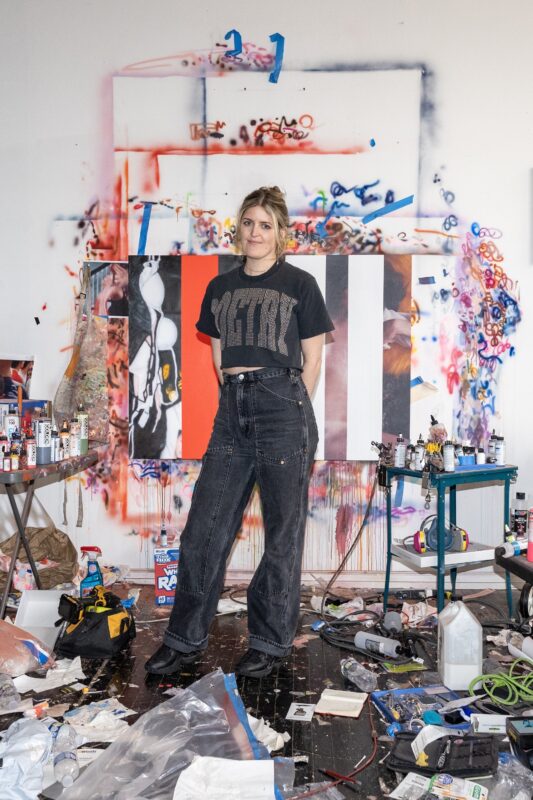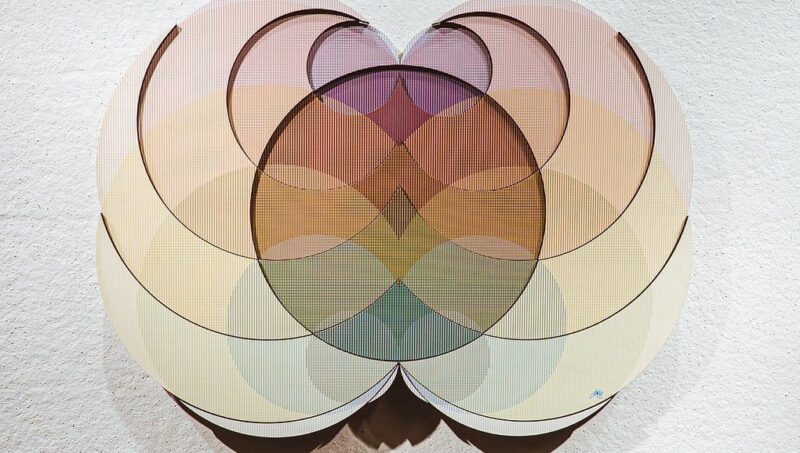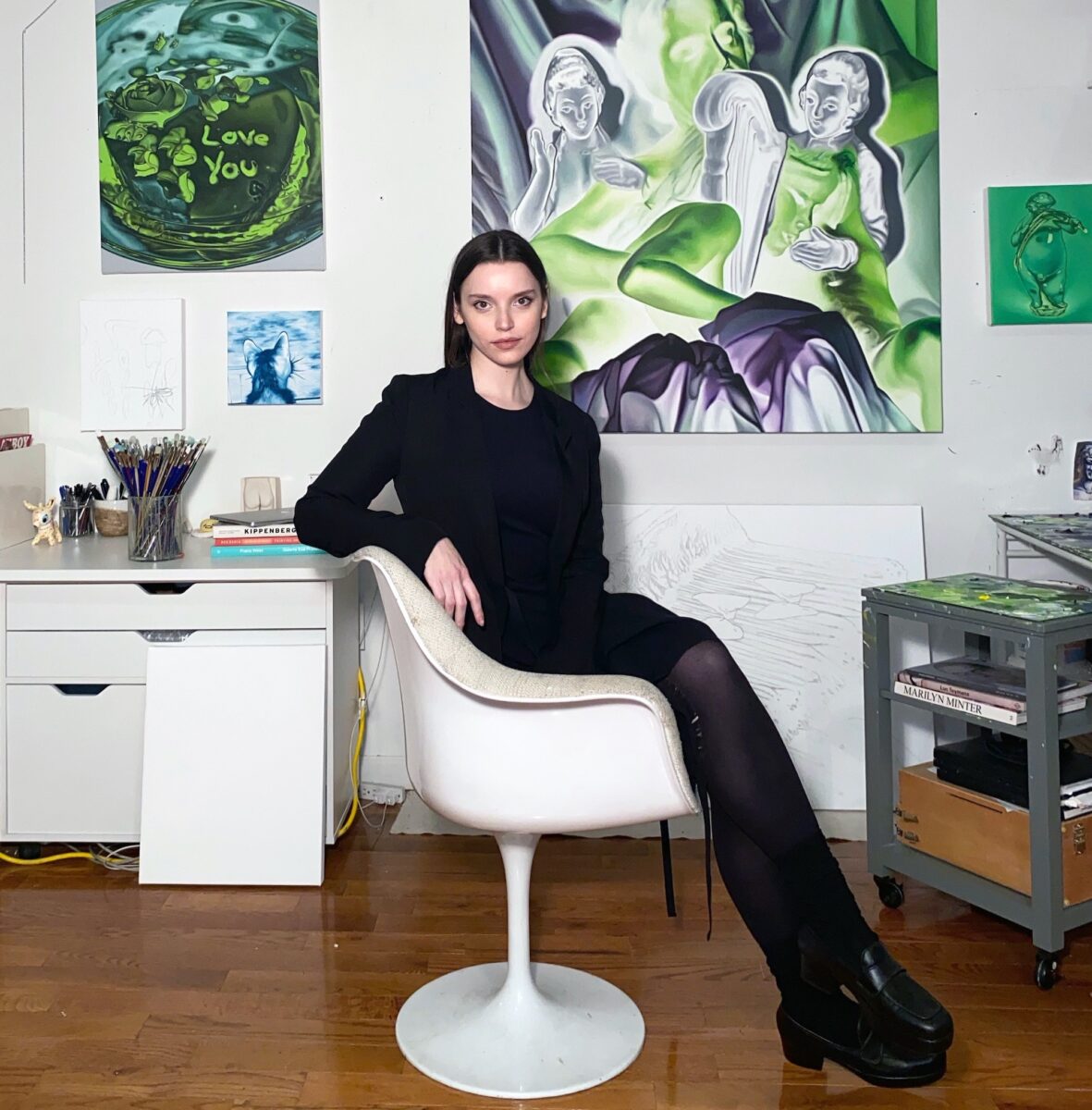
Charlotte Fox builds hyper-saturated worlds based on exaggeration and fantasy. Fox is a painter living and working in New York City who is known for appropriating cartoons, vintage porn, and film stills with her own photography to create collaged scenes in oil paint that provide a rich thematic environment. These mythical scenes are not only an extension of Fox’s painterly talent but of her personality as well. The combinations of imagery do not challenge each other but intermingle and fuse together to become something else.
Precisely controlled moments of technique combine with intuitive and loose investigations within Fox’s paintings. Her work explores moments of dream states and fantasies told in fragments, revealing slippery glimpses of what may or may not have occurred. Fox’s work is a mesmerizing blend of turmoil and vibrancy, and she utilizes diverse methods of inspiration to delve into themes of accompaniment, decay, objectification, intimacy, and pleasure. Fox holds a BFA in painting from the School of the Art Institute of Chicago. She has exhibited work nationally and internationally at As It Stands, Los Angeles; Moosey Art Hoxton, London; H.G. Chicago, Chicago; 303 Gallery, New York; Reena Spaulings Fine Art Gallery, New York; Onground Gallery, Seoul; and Hoxton Arches, London.
Fox has an upcoming solo exhibition at McLennon Pen Co. Gallery in June 2024 and will be showing work in the project room at 303 Gallery in November 2024.
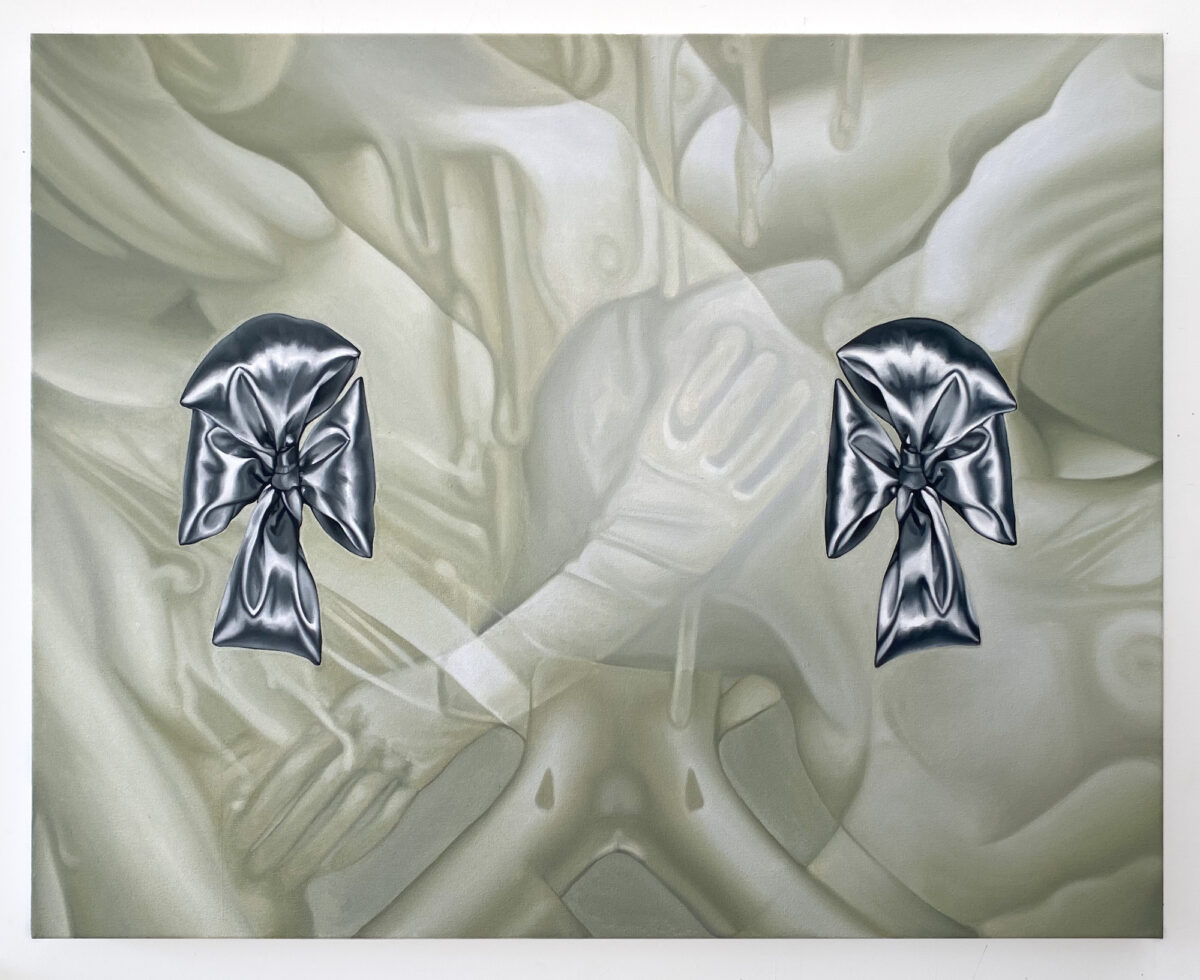
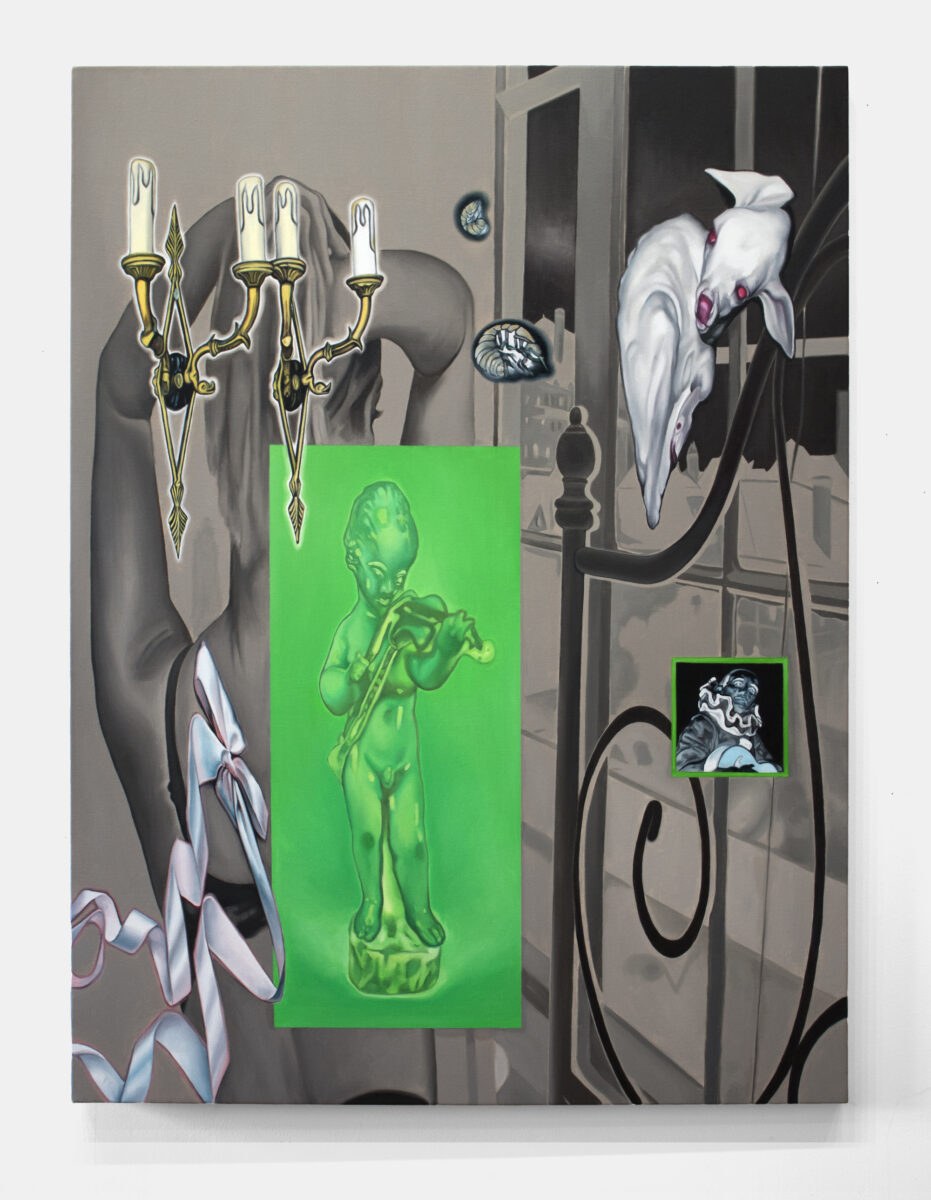
Phillip Edward Spradley: Can you talk about your relationship with paint, color, and layering?
Charlotte Fox: I’ve been having a love affair with chartreuse and bright greens, but I am doing my best to let her go. I try to look for colors that unnerve or are slightly wrong with a sickly undertone. With layering, I suppose I have always been drawn to complicated images that have a lot of information in them to decipher. I do a lot of collaging both physically and digitally, to sort of build a new monster out of all these different interesting and beautiful parts.
P.E.S.: Your paintings are immersive and experiential, closer to a vibration and beyond a linear form of storytelling. How would you break down your visual language; what are the pillars of consistency that are embedded within your work?
C.F.: I would describe my art as glimpses into experiences of repulsion and desire through the lens of fantasy and fragmented or fictionalized self-narrative. Pockets of recognizable imagery that you can hold onto, enmeshed with the less desirable and less recognizable/grounded. Movement is very important in my paintings, that there be some kind of energy swirling around the canvas, joining all the elements together. I would say that I am always referencing the human body/form in some capacity, either rendered or merely the suggestion of it through its absence. Also Humor. I try to have a balance of sincerity and humor.
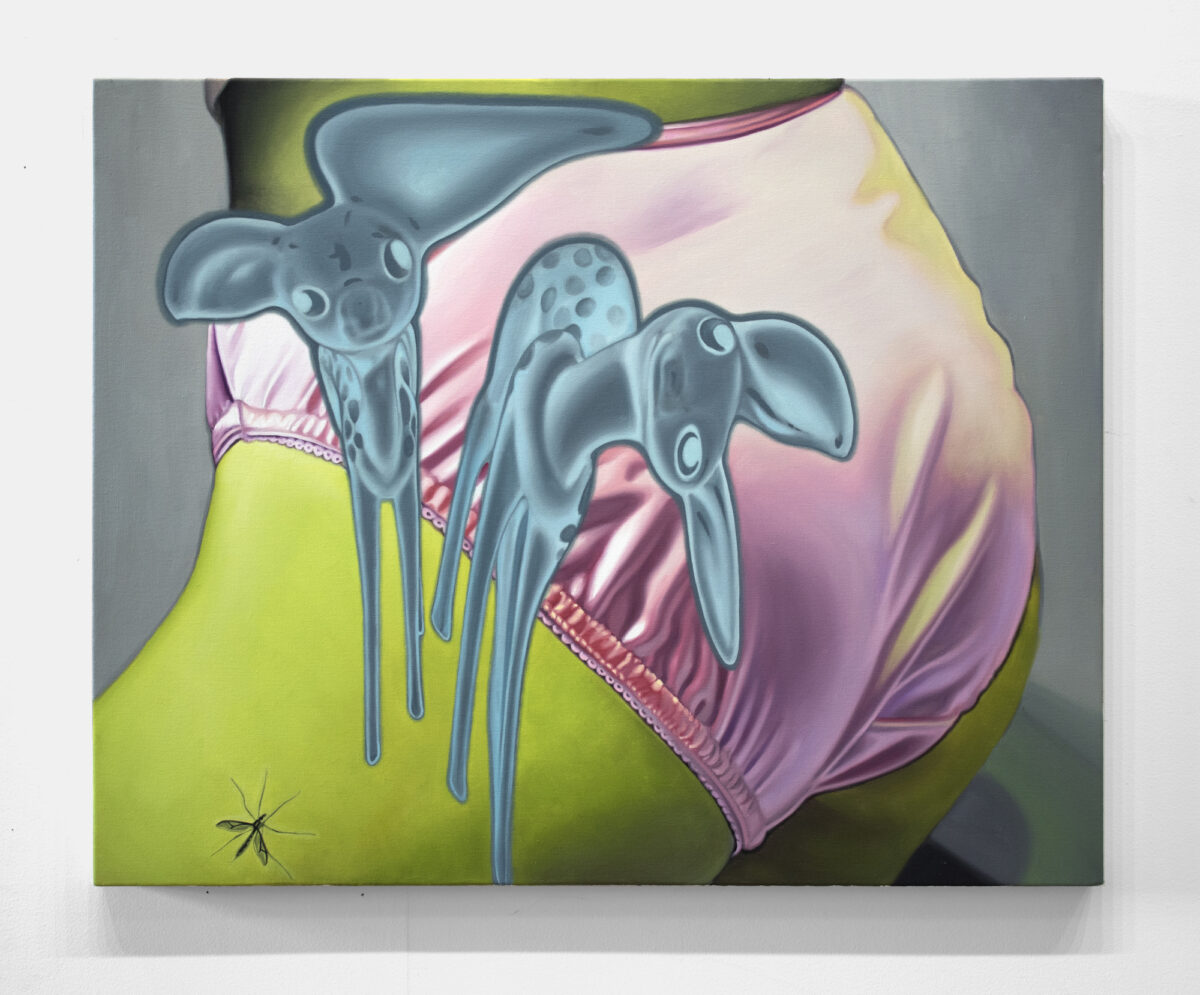
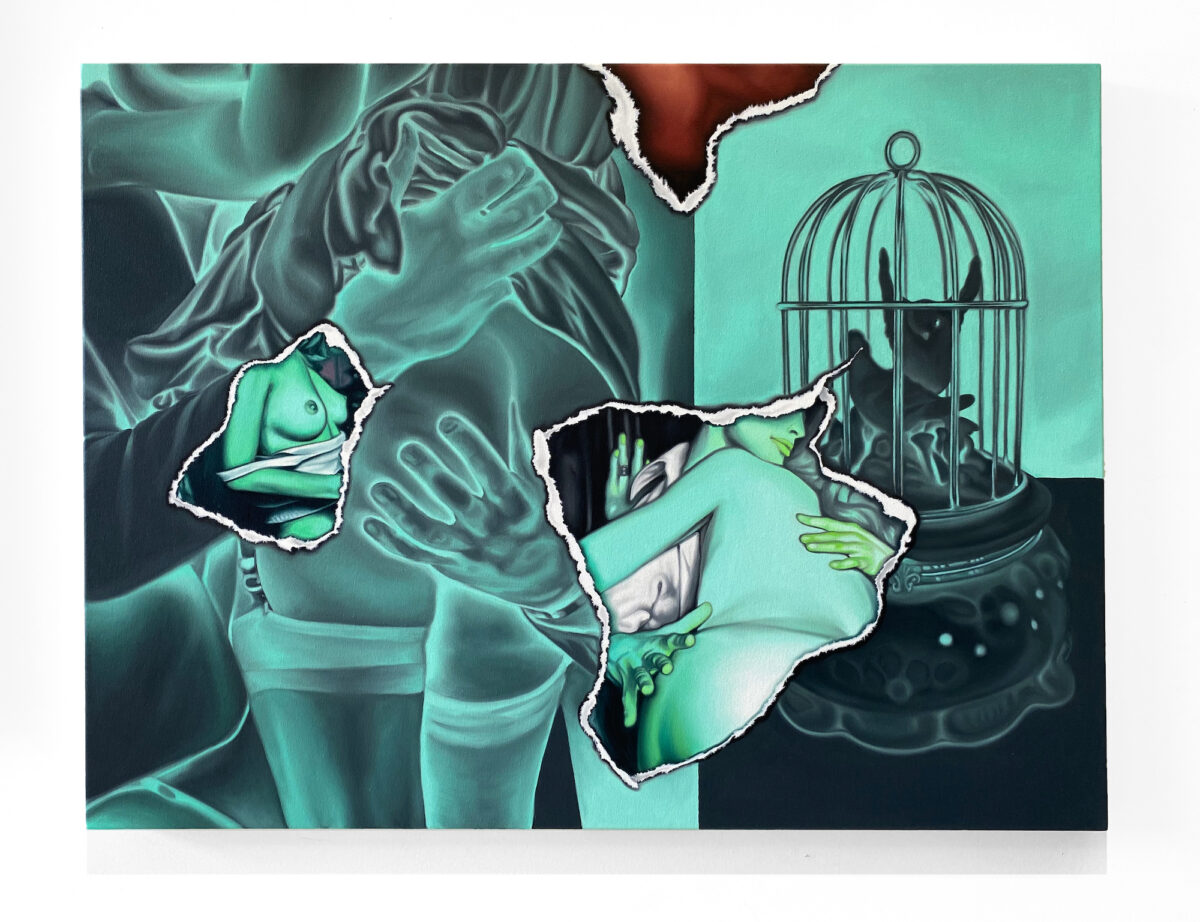
P.E.S.: It’s clear that you are citing so many motifs and subjects and doing so much research to build up your paintings. Can you share how you research and utilize other forms of culture and how you decided to incorporate them into your work?
C.F.: The images I incorporate into my paintings come from all over; vintage porn magazines I cut out and collage back together, my own photos from my phone, found images I’ve sourced over the years, cartoons, and classic films. I have a million (unorganized) folders of saved images on my computer. Recently I have been collecting images of porcelain angels and antique furniture from ebay. When I am first ‘building’ a reference image for a painting, I am usually inspired by just a shape or color, or the composition of a single moment in a movie. From there the image transforms over and over until it makes sense.
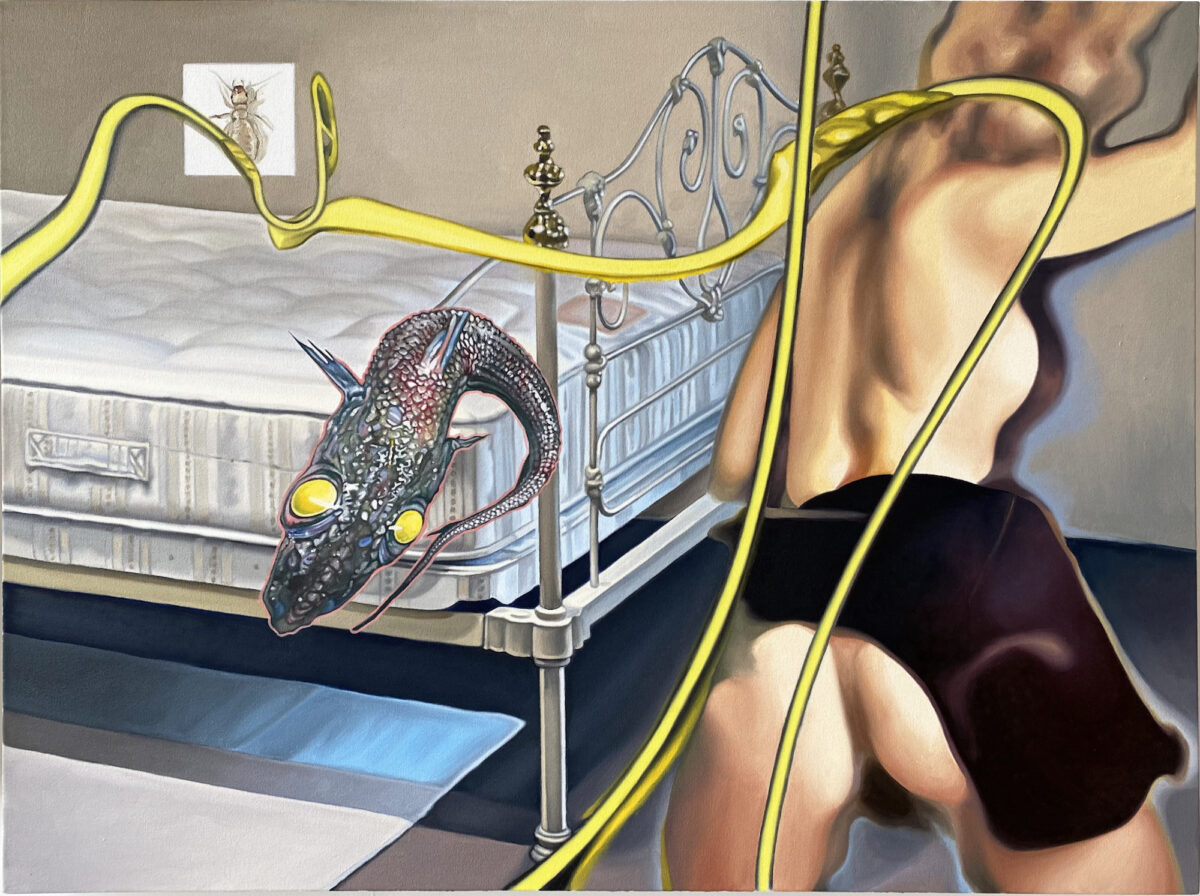
I am a big cinephile and often find inspiration in film; playing with ideas of voyeurism and narrative, as well as formal aspects of mise-en-scène in how to ‘structure’ an image and play with depth/flatness. I usually look at work by Tarkovsky or maybe Antonioni, but also terrible B horror movies I find sometimes have really beautiful stills and colors that I want to utilize as part of a painting.
I am also someone who enjoys the history of painting and I look to the works of old master artists for formal components as well as their ability to emote. For example; I am, for some reason, always thinking about Manet’s Fish (Still Life), 1864, and how each creamy brushstroke is so intentional and holds so much energy. I want to have a small piece of that in all of my work. With painting, whatever you make is always in dialogue with paintings that have come before it to some extent, and I find that really compelling and interesting to work with; I think it offers more layers to every work.
For me all of these influences and references are simultaneously present, they don’t occur as chapters or events one at a time. I find it impossible to separate them from one another, as each informs the next. The same goes for my paintings. Why depict one thing at a time when nothing is really isolated and everything is connected and constantly altering the meaning of one another. The juxtaposition of these different elements occurring together lets us see them in a new light, and consider them differently. There is always a movie, a picture online, a memory, that is inescapable and makes its way to the forefront.
P.E.S: You have a particular way of working, which is typically painting a single canvas at a time until completion. Do you implement any other restrictions on your working style?
C.F.: Maybe less restrictions and more rituals – I like to spend about half the time creating the reference image for the painting, so that I have the planning out of the way. When I’m painting I want to focus on my hand. Painting feels like a commitment and once I start I’m fully devoted. I have to give it my full attention, and sometimes I go days without leaving my studio.
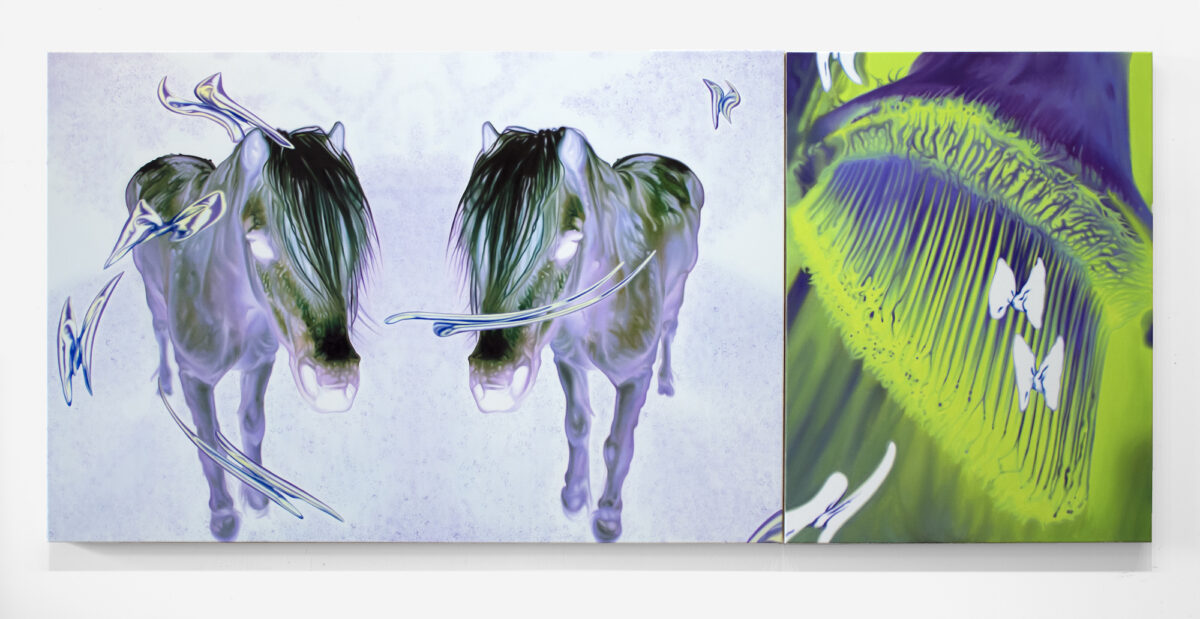
P.E.S.: There are a large variety of insects and animals used in your paintings; these creatures are typically juxtaposed with nude figures who are susceptible, presenting, or engaging in intimate acts. How do you view the inclusion of these insects and animals; do any of them hold a particular significance for you?
C.F.: I’ve always been interested in the history of animals depicted in paintings. I tend to use them as signifiers of fantasy, childlike innocence, or for storytelling narration, but not as heavily symbolic as you might find in a Renaissance painting with religious significance. Sometimes anthropomorphized, the animals take the place of a human figure, which I feel frees up the painting from everything that comes with the human depiction, such as our own biases. I find insects’ delicate, intricate bodies really beautiful. I like to use them sort of as a tool to bring you into the space/world of the painting. When they float on top of the surface they can act as an anchor to the familiar but lead you into the image. Insects are often associated with decay/ rot or signify something spoiled or repulsive, so I think they are interesting to have alongside something opposingly, overtly beautiful in my work.
P.E.S: When I look at your paintings, I appreciate all of the different textures that are presented; sometimes I even feel a sticky, tactile sensation when looking at them. From your own perspective, can you communicate the types of senses viewers may experience when they encounter one of your paintings?
C.F.: I like to create a ‘push-pull’, an attraction and a repulsion, a wary intrigue to investigate further. I like the idea of it being sticky. Sort of sweet honey meets old bubblegum or human fluids. I hope viewers experience the softness to some of the harder images, and mostly just that they sit with it for a little longer.
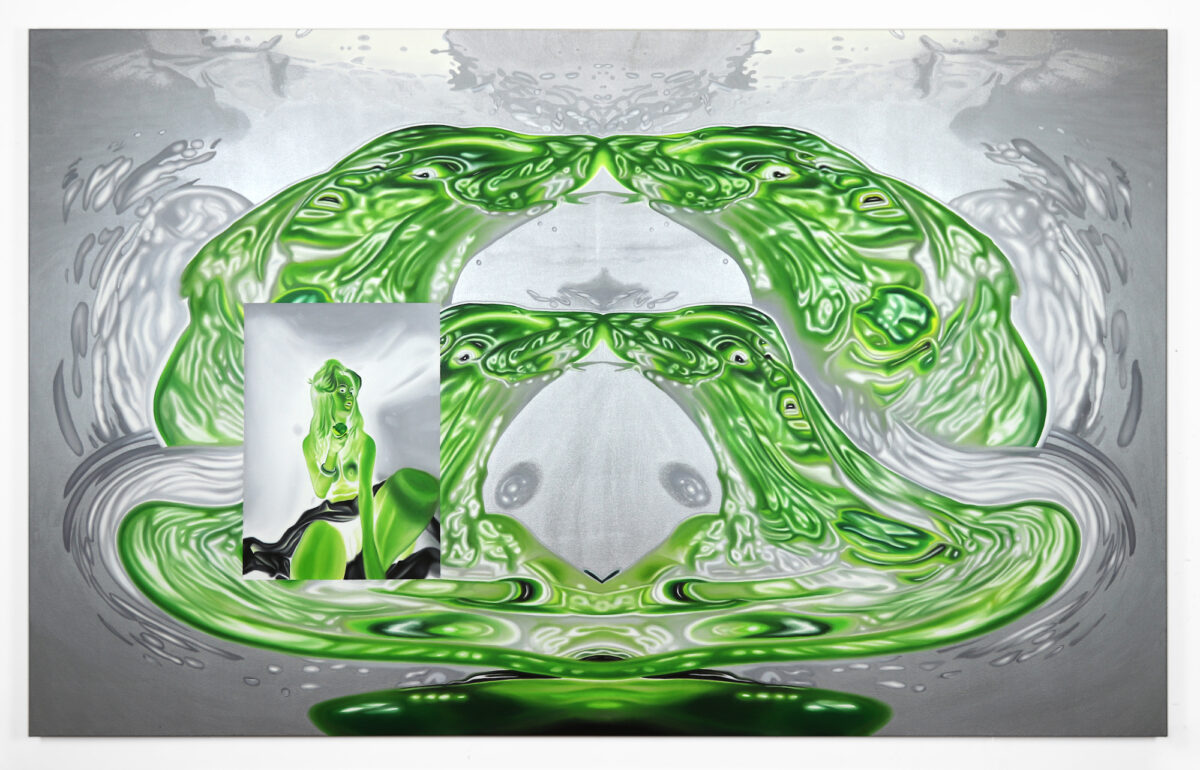
P.E.S.: As I mentioned, your painting has the ability to embody more than one thing at once. For example, there are faces, figures, body parts all emerging and disappearing into the general mass of the paintings. You’ve mentioned that you’re interested in making your paintings more abstract, but what do you hope to gain by further reinterpreting and expanding these forms?
C.F.: With my newer work I am playing with layering of images as opposed to having multiple images fully rendered exist side by side at least to the same extent. I want the images to dissolve into each other – sort of fuse into themselves and further distort and fragment. The same way things become distorted and change when we try to remember them, or how everything in a dream feels just a bit ‘off’ but you aren’t sure why – pulling the images apart and into each other. To ‘suggest’ form makes you work for it more, and I like that it could maybe suggest multiple forms within. By expanding and abstracting, I’m looking to engage the image as a whole.
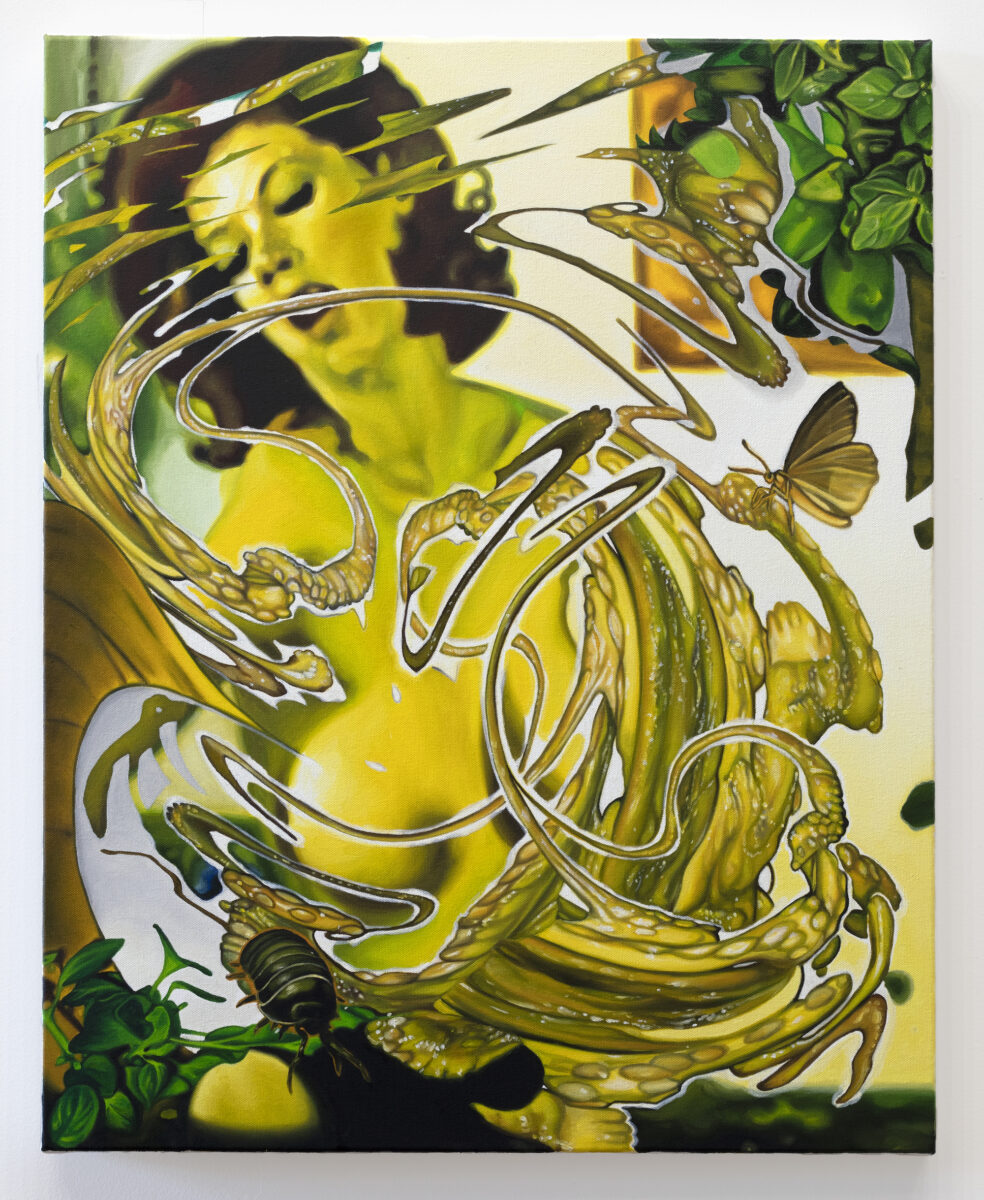
P.E.S: I have no doubt that it differs on the day or on the painting, but can you try and describe what you have felt before, during, and after the process of painting and then once it’s finally completed and hung? Relaxed? Relieved? Fulfilled? Depleted?
C.F.: When I first have an idea for a painting I am very excited and have this belief that I am of course ‘on to something’. While painting, it tends to be sort of a back and forth of second guessing myself (agony) during the slower steps of the process, and complete contentment. I lose all anxiety when I am able to just be alone and paint for hours. When it’s finished I am excited about whatever I learned through the process, or was able to further in the work. Usually by the next day however I am done with it, discontent and feel, though it may be a stepping stone in the bigger picture, I am still so far from making the painting I want to make. Feeling like the work is never quite there is exciting and keeps me going, but it is also quite frustrating.
P.E.S: When creating art or conceiving a potential painting, what is something that you care less about now that you used to place a lot of importance on and energy into?
C.F.: Trying to control what the viewer may interpret. That’s not to say that I don’t care what the viewer takes away from my painting, but when I worry too much about a painting being understood perfectly, it becomes too heavy handed and controlled, and the narrative is bogged down and flat. I’ve learned to let the image make sense to me, and allow it to be complete when it feels complete, and not second guessing or reworking the possible outcomes. Letting go of worry and allowing for more ‘accidents’ or less planned out moments to happen has also been an important way of letting go of control.
P.E.S: Can you talk about what you have in store for the future: What is something you hope to delve into or what we as an audience can look forward to or expect from Charlotte Fox?
C.F.: I have two projects coming up that I am very excited about. With the first I’m playing with ideas of interior and intimacy in both the scale of the work and how one engages with it. With my second project I’m doing somewhat the opposite and blowing up the paintings in scale. In both I am looking to expand the images into more layers and see how far I can pull apart the form and have it melt.
To learn more about Charlotte Fox, follow her on Instagram @lottyfox or
charlotte-fox.com
